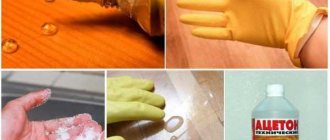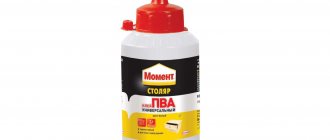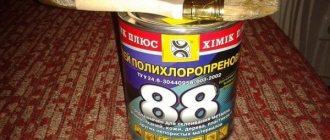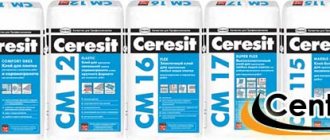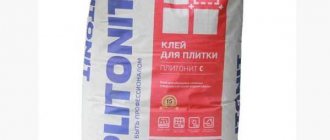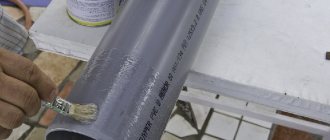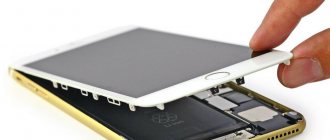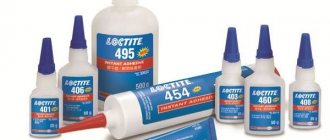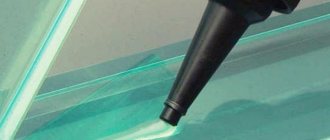Super glue gel “Contact”
“Contact”
Super-glue gel “Contact” KM 432-318 GL has a fairly dense jelly-like consistency, it does not flow and is absolutely transparent. One-component “Contact” is designed for reliable connection of such materials as:
- rubber (but not silicone),
- solid wood and other porous materials,
- leather,
- PVC plastic,
- metal,
- porcelain.
Not suitable for working with ABC plastic, polypropylene, polyethylene and Teflon.
"Contact" KM 432-318 GL
Secondary “Contact” KM 432-318 GL has the following properties:
- high seam strength,
- gluing speed up to 30 seconds,
- dries quickly,
- ten second correction possibility,
- can be used as a material for filling small cracks and gaps,
- withstands from –50 to +80 degrees.
The instructions for use are simple and no different from the conditions for using Moment super glue, except that it is applied to one of the surfaces to be glued. You can remove glue that gets on your skin using soapy water and a rich cream.
Second universal “Super Moment gel”
Second glue Moment
Secondary glue “Super Moment Gel” is available in a metal tube of 3 g. The price for one unit does not exceed 50 rubles, so it is quite affordable for all segments of the population.
Universal glue “Super Moment Gel” will reliably and firmly connect:
- metal,
- plastic,
- wood and cork,
- cardboard and paper,
- leather and fabric, rubber,
- porcelain and clay.
Not suitable for flexible connections or for working with polyethylene. Since the composition contains harmful toxic substances cyanoacrylate, Super Moment glue gel 3 g is not allowed for gluing dishes and children's toys. When working with it, you must follow certain safety rules:
- do not inhale fumes,
- ventilate the room well,
- avoid contact with heating elements, open fire,
- In case of contact with skin, remove with soap and warm water,
- In case of contact with mucous membranes, consult a doctor.
- Instructions for use:
- prepare the surfaces to be glued,
- unscrew the cap and remove the protective membrane,
- apply a thin layer of glue to the edges,
- strongly squeeze the surfaces together, holding them in this position for about 1 minute,
- Clean the tip of the tube from residual glue and screw on the cap.
Species diversity and characteristics
A universal glue called Moment can cope with almost any material. At the same time, the resulting seam is clean and highly resistant to wear. This makes the substance extremely popular among consumers.
The “Moment” category of contact adhesives includes a wide range of varieties of adhesives for gluing products made of wood, metal, natural or eco-leather, as well as other materials.
The domestic market of building materials, as well as related products, offers a wide selection of products from this category. Namely:
- universal adhesive composition “Moment 1” is suitable for a wide range of materials;
- Moment Crystal glue is a colorless polyurethane adhesive;
- "Moment Marathon" is used mainly in the footwear industry;
- “Moment Gel” or adhesive gel: has a gel structure;
- “Moment Rubber” is intended for gluing all types of hard and foam rubber;
- “Moment 88” is characterized by special strength.
All these types of compositions in tubes of 30 ml and 125 ml, according to the manufacturer’s instructions, are intended for connecting various types of materials and give a person the opportunity to make a truly reliable and durable connection.
Differences between Moment Crystal glue and other compounds, instructions for use, advantages
Universal glue Moment Crystal has become simply indispensable in everyday life. It allows you to quickly glue different materials - from ceramics to rubber. Its main advantage is the almost complete invisibility of traces from the connection of parts. The adhesive composition is high quality and has excellent characteristics.
Glue Crystal
The content of the article
Components and characteristics
Moment is a universal adhesive, transparent, its composition is waterproof. With it you can reliably and permanently glue different materials.
The crystal qualitatively connects wood, metal, porcelain, rubber and other surfaces. The joint area is provided with high strength. The glue can also be used for fabrics, because it does not leave marks or stains and does not deform the processed material.
The glue is available in a metal tube with a volume of 30 ml or 125 ml.
The crystal does not change its parameters even under the influence of high humidity or temperature changes. Thanks to this, the composition is in great demand and has a large number of positive reviews from experienced builders and from those who prefer to do all the work themselves.
The glue has a complex chemical composition; the latest technologies are used to create it. The main components are:
- polymers from the group of polyurethanes;
- ethyl acetate;
- acetone;
- stabilizers.
Stabilizers increase the composition's resistance to moisture. As it hardens, the composition crystallizes, due to which the joints have high strength.
Varieties
The Moment line of contact adhesives includes the following types of compositions:
- Moment 1 is universal – suitable for most materials;
- Moment Crystal is a colorless polyurethane composition for various materials;
- Moment Marathon - used in most cases in the footwear industry;
- Moment Gel – adhesive with a gel texture;
- Rubber moment – suitable for connecting any hard or foam rubber;
- Torque 88 – characterized by increased strength.
Each type is sold in tubes of 30 ml and 125 ml. These compounds help to make truly reliable connections between different materials.
Specifications
The moment is characterized by the following properties:
- transparency in liquid form and after hardening;
- resistance to environmental factors due to the polyurethane base;
- during crystallization of the seam, the degree of adhesion of the two surfaces improves;
- water resistance - can be used for shoes and rubber boats;
- resistance to dilute acids and alkalis;
- frost resistance - can withstand temperatures down to minus 40 degrees;
- good tolerance to high temperatures up to 70 degrees;
- temperature range for operation is 18 – 25 degrees;
- Warm, dry air accelerates crystallization, and in the cold, solvents evaporate slowly.
There are 2 main limitations for use:
- it is prohibited to use it for dishes;
- The use of polypropylene, polyethylene and Teflon products for repair is prohibited.
Instructions for use
The instructions for working with Moment are as follows:
- To connect the surfaces, they are first thoroughly dried and cleaned using fine-grained sandpaper.
- After cleaning, the surface is degreased with gasoline or acetone, then glue is applied in an even layer.
- Both surfaces are coated with the composition. Leave them outdoors for 15 minutes. A film should appear on the glue. Before connecting, you need to touch it with your fingers - if it does not stretch or stick, then you can connect. If the materials absorb well, then the composition must be applied a second time.
- Press the parts firmly and hold for a few seconds. The effectiveness of the operation depends on the effort applied. After 7 seconds, the position cannot be corrected.
- It is important to press from the center to the edges so that air cannot accumulate in the central part, worsening the grip.
Using an adhesive
- You can use the repaired product after 24 hours.
- As a result, with the help of the composition, Crystal obtains a high-strength connection that is resistant to wear, the negative effects of high temperature, solutions of acids and alkalis, and moisture.
Useful tips
According to reviews, Crystal is reliable and durable. The quality of the resulting seam corresponds to that declared by the manufacturer.
During operation, it is important to remember that it is highly flammable. All operations with it are carried out away from sources of fire, only in a room with good ventilation.
Also, to comply with safety precautions, it is recommended to carry out work in special clothing. If the adhesive gets on the open surface of the skin, it provokes a burning sensation, irritation, and a local allergic reaction.
During work, it is necessary to remove excess glue and random stains. You can wipe them off in the following ways:
- You can clean the tools with gasoline;
- gasoline also helps remove fresh stains on clothes;
- Dried glue can only be removed from fabrics by dry cleaning; from other materials - with gasoline.
The quality of Moment Crystal corresponds to what the manufacturer claims. Every home should have such glue to use in case of unforeseen circumstances and fix things.
gipsohouse.ru
Security measures
“Moment Gel” is a toxic substance that can harm human health. To minimize the negative impact of such an adhesive composition, all work must be carried out in a well-ventilated area. Providing ventilation will facilitate the removal of toxic substances, as a result of which the likelihood of poisoning from harmful fumes will be reduced. If this rule is neglected, the master may experience headaches, dizziness, and nausea.
To remove dried glue residues from the surfaces being treated or from tools, it is recommended to use substances for diluting paint and varnish products. Fresh drops of waterproof glue can be easily removed with a rag soaked in gasoline. The composition that gets on clothing can only be removed by dry cleaning.
What is superglue
The composition of the substance that we used to call “superglue” necessarily includes 97–99% cyanoacrylates, that is, cyanoacrylic acid esters, plasticizers, stabilizers, and in case of insufficient moisture in the joint - activators, as well as retarders.
To obtain an adhesive gel, ultrafine silicon oxide is also added to the composition for thickening. Solvents are not included in superglue.
The mechanism of action of superglue is actually simple - under the influence of slightly alkaline agents (ordinary water is one of these substances, and atmospheric humidity is quite sufficient), the substance polymerizes, that is, it hardens, becomes hard, while reliably fastening both surfaces together.
Conventional adhesives based on cyanoacrylates can easily withstand a load of 150 kg/cm2, and more advanced ones, for example, Black Max from Loctite - 250 kg/cm2. The heat resistance of regular superglue is up to 70–80 degrees, modified - up to 125 degrees.
Areas of use
Contact adhesive is used in cases where damaged items need to be quickly repaired. Its substance is ideally combined with various types of plastic materials. It also glues porcelain, glass, ceramic, wood, metal, and rubber surfaces.
It helps to splice textiles, cardboard and paper. The considered type of moment glue “Moment” is incompatible with polyethylene and polypropylene. It is also prohibited to use the composition to glue pieces of broken dishes intended for cooking and storing food.
Cyanoacrylate glue: varieties, technical characteristics and features of use
During installation and assembly of various parts made of polymers and metal-plastic, glue is often used. This is the best option when the presence of additional holes in the part makes the connection more vulnerable and susceptible to various influences. One of the best compositions is cyanoacrylate second glue . This publication contains detailed information about this substance.
Cyacrine glue has the ability to glue even those surfaces that differ in quality and structure.
Positive aspects and features of the composition
The advantages of the produced adhesive are represented by the crystallization of the hardening seam, which improves the adhesion force to the treated surface. With prolonged exposure to non-aggressive alkalis and acids, the performance properties of the applied composition are observed to be preserved. Transparent universal adhesive “Moment Gel Crystal” resists the negative effects of subzero temperatures and can be easily stored for up to two years.
The appearance of this possibility is generated by the room temperature, varying from twenty degrees below zero to thirty degrees above zero. If heated air contains a small percentage of humidity, crystallization reactions accelerate. Cold slows down the evaporation of solvents, prolonging the polymerization period of the substance. The hardening material forms a durable layer of transparent film. It blocks the path for moisture trying to seep into the structure of the product being repaired.
The time for complete hardening of the film coating reaches a maximum of three days, and the repaired product can be used one day after fixing the parts. Restoration of the original consistency and performance properties of the frozen mixture occurs at room temperature. The relatively high coefficient of adhesive strength specified by the manufacturer allows the repaired item to be immediately subjected to further processing operations.
It has mostly only positive reviews and a detailed description on the packaging. Available in containers of 30 ml and 125 ml.
Cyanoacrylate second glue: technical characteristics and properties of the adhesive composition
Currently, many well-known companies are engaged in the production of cyanoacrylate glue, which glues everything tightly. The main characteristic of the substance is its high level of adhesion to a huge number of different surfaces, including wood, glass, metal, plastic and rubber. It should be noted that cyacrin glue is absolutely not affected by substances such as water, oil, gasoline, as well as various alcohols.
The consumption of cyanoacrylate glue per square meter is only 30-50 g.
Cyanoacrylate second adhesive works well with gaps smaller than 0.1 mm. It can be used to join tightly fitting parts. There are reagents with a high level of viscosity that are optimal for working with gaps of about 0.25 mm. The consumption of such glue per square meter is about 300 g. If it is necessary to eliminate a large gap, then Cosmofen cyanoacrylate glue or composition CA-4 is usually used.
As for the technical characteristics of cyanoacrylate glue, they are determined by the scope of application of the substance.
Let's look at them in more detail:
- Physical state. Cyanoacrylate-based adhesive has a thick consistency and a high degree of viscosity. Usually the substance is transparent, but there may be other options - it all depends on the manufacturer.
- Package. The glue is produced in a completely sealed container. The packaging has been supplemented with instructions for use describing precautions when working with this substance.
- Solidification mode. In conditions of low humidity at room temperature, the gluing process is carried out in a few seconds. In case of high humidity, this process is carried out almost instantly.
- Operating temperature range. All one-component and two-component cyanoacrylate adhesives can withstand temperatures from -60 to +80 ° C. There are special modified heat-resistant compounds that can retain their characteristics for a short time even at elevated temperatures (up to +250 ° C).
The strongest connection is obtained in humidity conditions from 40 to 70%.
The connection formed by glue is reliable and durable, resistant to environmental conditions and mechanical stress. After opening the sealed bottle, experts do not recommend storing the substance for a long time. This is due to the fact that under these conditions the physical and technical properties of the glue are violated; it can become brittle and unreliable after polymerization.
It is also necessary to note the small consumption of cyanoacrylate glue per square meter - it is only 30-50 g.
Therefore, using a dispenser, glue can be processed:
- using a 400 ml container – about 13 m²;
- via 100 gram packaging – 2-3 m²;
- 20 g tube – approximately 0.7 m².
On a note! The more liquid the cyanoacrylate glue has, the better it glues hard surfaces. The completely transparent adhesive is ideal for glass structures. It is impossible to glue precious metals with cyanoacrylate glue.
The operating temperature range of cyanoacrylate glue varies from -60 to +80 °C.
User ratings of the “Strength” tool
Let's consider the most informative reviews without unnecessary distractions. It turned out like this:
The woman treated the white glue stain on her husband’s trousers with the product, which had been “living” there for two years. Literally 10 seconds after treatment, I cleaned and washed the fabric with soap. There are no traces left! Anti-glue is relatively liquid and absolutely transparent
You need to work carefully, as it is easy to “overdo it” with it. The cleaner has virtually no odor
I tried to clean the glue stains on the table, trying to remove the stain after one, then seven, then ten hours. In all three cases, the anti-glue damaged the varnish of the table and required ten hours to completely clean it.
The conclusion is still the same: if the user carefully read the instructions for using the product and followed its instructions, the anti-glue will not let you down! It is first necessary to check the reaction of the treated surface to the cleaner in a place inaccessible to view.
Choosing cyanoacrylate glue: price and popular manufacturers
Having familiarized yourself with the market of modern building materials, it is easy to see that there are a huge number of manufacturers who produce cyanoacrylate adhesives. When choosing the required composition, you should pay attention to the most popular models.
Pronto CA-4 is a completely ready-to-use product characterized by excellent viscosity and versatility. The substance does not require any additional additives or compounds to improve adhesive properties. This is an ideal product for home use.
For joining materials that are difficult to glue, Loctite cyanoacrylate adhesive is the best option.
Loctite cyanoacrylate adhesive is a polymerizing one-component composition with low viscosity. Ideal for joining materials that are difficult to glue.
Interbond is a two-component cyanoacrylate adhesive that is used when working with MDF, chipboard, rubber or leather. It gives the compound high moisture and heat resistance and acts almost instantly. The composition is sold in packages of 400 ml, as well as 20 g or 100 ml. The glue is characterized by a high ignition temperature and is fixed in 5-7 seconds. During storage, it is necessary to protect the packaging with glue from sudden temperature changes and direct sunlight.
Permabond C791 is a cyanoacrylate adhesive that is designed for reliable connection of various elastic and hard surfaces. The substance sets in a few seconds and is proudly called “second” glue. Since the composition has a transparent color, it is recommended to be used for gluing glass surfaces. It is very convenient to use Permabond cyanoacrylate glue, since the substance is liquid. This function is very important for rapid hardening of the composition. In addition, the glue is sufficiently water resistant.
The manufacturer Cosmofen provides customers with a huge selection of universal and specialized products. Cyanoacrylate adhesive Cosmo CA-500.200 is one of the most popular and most common adhesive compositions in this category. The substance is characterized by low consumption. Even the instructions for cyanoacrylate second glue CA-500.200 say that just a few drops of the reagent allow you to firmly glue many elements together.
Cyanoacrylate adhesive Cosmo CA-500.200 is the most popular and widespread.
In addition, if you follow all the recommendations specified in the instructions for cyanoacrylate glue, it can be stored open for a month. Before use, you need to carefully study the instructions for cyanoacrylate second glue CA-500.200.
In addition, cyanoacrylate adhesive CA-500.200 is widely used in industrial production of various sizes, namely:
- when creating sewer and sealing structures;
- in the production of various types of transport;
- in the radio-electronic field;
- in the manufacture of household appliances, children's toys and jewelry.
The highest reliability of the connection is guaranteed by the use of Kernil glue. This composition is preferred by fishermen and tourists to patch damage to inflatable boats. There are also a number of popular Chinese companies that produce cyanoacrylate-based adhesives:
The market also offers a number of popular Chinese cyanoacrylate adhesives.
- Lanxi Kingway;
- Taizhou Henco-Glue;
- Hunan Baxiongdi New Material;
- Audited Supplier and many others.
Universal “Super Glue Gel”: glues everything together in a second
Universal instant Super-glue has long become a favorite material for use in everyday life, in production, for repairing leather goods and creativity. Numerous tests have led to the fact that manufacturers have developed the optimal composition, which includes:
Second gel Moment
- rubber resin,
- formaldehyde resins,
- rosin ester compounds,
- acetone,
- various hydrocarbons.
Depending on the manufacturer and brand, the composition of Super Glue may change, but in any case it remains a completely synthetic substance that must be handled with extreme care and not given to small children.
The instructions for the Super Glue Gel highlight the following general technical characteristics:
- suitable for any materials (exceptions occur individually for each brand),
- waterproof,
- storage conditions in original packaging in 3 g packages: from -20 to +30 degrees for 24 months,
- does not lose technical qualities after defrosting.
How to use adhesive gel - what gel for touchscreens
Gel glue is a modern, convenient and effective means for securely bonding a wide variety of materials - from wood and metal to wallpaper and artificial nails.
The scope of application is so wide that neither the furniture, nor the automotive industry, nor construction can do without this product.
companies producing
universal gel glue , but we can single out the leaders, which are found in almost every home and are available to most craftsmen and builders.
A popular product is called Moment glue. It is ideal for small construction and household work. Glues paper, wood, cardboard, leather, is suitable for working on porous and vertical surfaces, does not drip or run down.
The Kores company offers a large selection of adhesive gels at affordable prices. They are suitable for home use. Quickly fasten leather, paper, rubber, plastic. They are economical to use and safe for the skin.
Glue gel transparent Contact is a one-component product based on ethyl cyanoacrylate. Designed for everyday use by non-professional craftsmen.
Bonds rubber, hard wood, porcelain, metal. Gives a strong adhesive seam, sets in 20-30 seconds.
Contact super glue gel does not drip or spread; its consistency is similar to jelly, so it can be used on vertical surfaces.
The product is very easy to use. It is applied to one or both surfaces, previously degreased and cleaned. The items are placed next to each other and left to dry.
Gel moment glue
As mentioned above, glue moment universal gel is the leader in the market of similar products.
Its advantage is that it glues a variety of surfaces well: paper, metal, rubber, ceramics, porcelain, PVC, glass, felt, leather.
The scope of its application is very wide; builders and finishing craftsmen cannot do without the use of this product.
Moment universal gel glue
The product contains phenol-formaldehyde resins, chloroprene rubber, ethyl acetate.
The adhesive is waterproof, reliable and versatile. Available in packages of various sizes.
- Before using the product, the surface must be cleaned, degreased, and sanded.
- The gel is applied in a thin layer to both surfaces, pressed against each other and left for about 20 minutes.
- In this case, it is important to squeeze the objects as tightly as possible so that the glue sets faster and better.
Super moment gel glue is another popular household product. Suitable for small household work, car repairs, and workshops.
Bonds rubber, wood, metal, leather, rubber, cardboard, plastic. Suitable for both horizontal and vertical surfaces, including porous ones.
- Surfaces must be dried and cleaned before work.
- The glue is applied evenly in a thin layer, the objects are pressed for a minute under strong pressure.
- The glue sets instantly. It is recommended to carry out work in a well-ventilated area, since the composition includes cyanoacrylate.
VIDEO ON THE TOPIC
Glue gel for touchscreens
Glue gel for touchscreens
Mobile phone repair technicians often encounter broken screens that need to be replaced or repaired. And when it becomes necessary to glue glass directly to the touchscreen, you cannot do without a special gel on a transparent basis.
The product is applied between the screen and glass and, after drying under an ultraviolet lamp, sets securely.
Uv loca gel glue is one of the most popular among smartphone repair specialists. It is packaged in convenient plastic syringes that protect the product from ultraviolet rays during transportation and storage.
It hardens very quickly (it takes about 30 seconds, but the manufacturer recommends waiting up to 3 minutes).
If you don't have an ultraviolet lamp at hand, you can work in sunlight, but the gel will take longer to harden.
Used using the following technology:
- Clean the display and glass, remove any remaining old glue, degrease all surfaces,
- Apply about 2 g of product to the center of the display,
- attach the glass to the display,
- avoiding bubbles, spread the gel over the surface,
- after a few minutes, place the display under a UV lamp for three minutes or use an ultraviolet flashlight (if you work in sunlight, it is worth remembering that window glass does not transmit ultraviolet radiation, so depending on the light intensity, the curing time will increase).
The thinner the layer of glue and the smoother the surface, the more reliable the bond will be.
The materials themselves must be slowly heated to about 30C using a regular hairdryer. After heating, it is important to use the glue within five minutes.
Since the product is aggressive to the skin and mucous membranes, it is important to take precautions - use goggles and protective gloves.
RELATED MATERIALS
etogel.ru
Types of Moment adhesives
The Moment line of polyurethane adhesives is produced by the manufacturer Henkel. According to user reviews, the demand for this series is the highest among its analogues. The following types of contact adhesives are available for sale:
- “Moment No. 1 Classic” (Universal). The glue is inexpensive and suitable for most known materials. It has a high level of adhesion, thickness, and fast drying.
- "Moment Gel". This product has a gel structure, is a type of superglue, and is available not only in tubes, but also in canisters.
- "Moment Crystal". An absolutely transparent composition based on polyurethane, used in everyday life, repairs, and construction.
- "Moment Marathon". Most often purchased for shoe repair, widely used by craftsmen. Very resistant to environmental factors.
- "Moment 88 Extra Strong." This product guarantees the highest adhesive strength and is not afraid of water or frost.
- "The 60 second moment." One-component adhesive characterized by fast drying. Convenient for use on vertical bases.
Second glue: features and composition of the substance
Cyanoacrylate adhesive has a high level of adhesion to a wide variety of surfaces. All this is possible thanks to copolymers that are part of any two-component cyanoacrylate adhesive. Each manufacturer has its own unique glue recipe, as well as the secrets of its production. This information is kept secret from competitors. The main feature of such adhesive compositions is the ability to perfectly hold surfaces together, even materials that differ in quality and structure. These reagents are also characterized by a long service life.
The main component of the glue is cyanoacrylate.
The glue is based on cyanoacrylate, as well as acids derived from it. They can reach up to 99% of the total volume. The adhesive also contains plasticizers and thickeners, which give it additional properties, such as water resistance, heat resistance, and adhesion. In order for the adhesive to better withstand vibration, abietic acid is used in combination with glycerin.
Cyanoacrylate is designed for gluing hard, porous and even elastic surfaces that can be in any position.
The main active component of the glue can be various monomers:
- ethyl ether performs well on a wide variety of materials and practically does not wear out;
- methyl ether promotes the adhesion of metals and duroplasts;
- butyl ether is an ideal substance for use in the medical field and special equipment;
- propyl ether is sometimes necessary for gluing metals and various elements exposed to high temperatures;
- compositions based on alkoxy ether do not have an unpleasant odor, but this is achieved by reducing the reliability of the compounds by 20-30%.
In environments that are too cold or dry, an adhesive activator must be used.
The principle of operation of cyanoacrylate-based glue is that it begins to set when exposed to ordinary water or weak alkali. When gluing with a very thin layer of substance, the setting process can occur without the participation of a cyanoacrylate adhesive activator.
On a note! The glue activator should be used in an atmosphere that is too dry or cold. It is especially effective when bridging large gaps or processing chemically inactive materials. To ensure the surface remains smooth and even, you must carefully adhere to the recommended spray distance. It must be remembered that some types of activators can adversely affect thermoplastics and varnished products. It must be taken into account that a primer should be used along with the activator.
Usage
The scope of application of Super-Moment glue is quite large. It is capable of gluing rubber, metal, wood, fabric, paper, leather goods, etc. But glue cannot glue everything together. It is not suitable for gluing polyethylene, polypropylene, stacks, dishes that will be subject to thermal reactions. It is also unsuitable for gluing very soft leather.
When using Super-Moment glue, you should adhere to the following instructions:
- the surface on which the glue will be applied must be dry and clean;
- for good adhesion, the surface must be degreased using gasoline or acetone;
- after application, you must immediately press the parts tightly against each other;
- a small emphasis can be placed on air humidity - the higher the humidity, the faster setting will occur and, vice versa;
- Accumulations of air should be avoided, which can have a detrimental effect on the future of the bond, because this will disrupt the structure of the dried glue, so the strength parameter will be much lower.
When using Super-Moment glue, you must adhere to the following safety rules:
- the gluing process must be carried out in a well-ventilated place, because a large accumulation of vapors emitted by this product can adversely affect the body;
- It is imperative to carry out work wearing gloves and goggles;
- store glue out of the reach of children;
- do not allow the product to come into contact with the skin or eyes;
- Be sure to get rid of the product after the expiration date.
Very often, when using Super-Moment glue, fingers get stuck together. If you follow safety rules, you can avoid this trouble.
If this happens, then you should use one of the methods described below.
- If some time has passed after gluing the fingers, then they should be placed under hot water or placed in a container in which soda and hot water should be diluted. Subsequently, the glue will soften and you can easily separate your fingers.
- You can use a drug called “Super-Moment Antikley”. It can not only wash your fingers off glue, but also helps clean the surface of excess. Before use, be sure to read the instructions and test it. If glue gets on clothes, it is almost impossible to wash it off, but the Super-Moment Anti-Glue product will return it to its original appearance.
Storage conditions and tips for use
The glue has a quick-drying property, for this reason the craftsman must be careful when applying it. The position of the part will need to be corrected quickly; sometimes such an adjustment leads to the need to remove the adhesive layer so that the adhesion is not broken. The fixation is highly durable, and removal will be problematic and may lead to breakage of the part.
When parts of the structure are pressed together, the connection begins, moving from the central part to the edges, then it will be possible to eliminate the presence of air gaps, which will reduce the reliability of gluing. Pressure is applied to the parts to tightly connect the products together.
If excess glue gets onto an unnecessary surface, it will need to be removed. For this purpose, it is enough to moisten a rag in gasoline and wipe the layer of glue when the solution has not yet dried completely. Dried drops will require the use of thinners.
The fixation is highly durable, and removal will be problematic and may lead to breakage of the part.
Classification
Superglue is classified according to the substances it contains:
- Without additional elements in the composition - one-component. This adhesive mass is suitable for quickly gluing different planes. After two hours, the product can be used.
- With fillers – two-component. Thanks to the additives, the glue gains electrical and thermal conductive properties.
The consistency of superglue can be:
- Liquid. This consistency is capable of penetrating into the smallest gap (0.05 mm).
- Average They have a wide range of uses due to their versatility.
- Viscous (gel-like). Can fill minor voids.
Second glue: types of substance
One-component transparent adhesive with cyanoacrylate characterized by very rapid polymerization under pressure. After drying, this composition forms a thin but durable film between the joined elements. These characteristics make the adhesive an optimal solution for metal and synthetic materials, including parts for medical equipment.
Cyanoacrylate glue can be one- or two-component.
The most commonly used second two-component adhesive is at home. Liquid compounds, due to their reduced viscosity, are able to close gaps up to 0.05 cm, and more viscous substances can seal a gap of up to 0.03 cm. Two-component adhesives are excellent for adhesion of rubber and leather parts, as well as products made from wood chips.
Note! The most reliable and durable connection is formed in humidity conditions from 40 to 70%. If it drops to 30% or less, the seam will harden for a very long time, and if the air humidity is above 80%, then the glue polymerization process occurs extremely quickly, which reduces the reliability of the joint. Reducing or increasing the temperature by 10 degrees will slow down or speed up the adhesion process of the glue by half. Optimal conditions for working with cyanoacrylates are from 20 to 24 °C.
Useful tips
Recommendations for use:
- Before starting work, if necessary, clean and dry the surface to be treated;
- the gluing result can be stronger if the material is degreased with acetone or gasoline;
- when using for the first time, you need to pierce the protective metal film in the tube with the upper end of the cap, and after finishing work, close it tightly by screwing on the cap;
- the glue is applied only to one surface in a thin strip, then the two sides should be pressed tightly against each other and wait a few seconds;
- The fixing time is affected by the air humidity in the room; the higher it is, the faster the setting speed will be;
- the process of gluing parts should begin from the center to its edges in order to avoid air getting inside, after which the edges are pressed tightly.
To safely use and store glue, you must follow simple basic rules:
- gluing should be carried out in a well-ventilated place;
- do not inhale glue fumes;
- If possible, wear glasses and gloves;
- Avoid contact with eyes and skin;
- keep away from children and direct sunlight;
- do not use after expiration date.
Adhesive Moment: Clear Crystal Adhesive and Clear Gel Adhesive
13 Feb
The Moment glue brand has been trusted for many years. The glue is of very high quality and reliable (especially if you follow the instructions for use). With the advent of transparent glue from the Moment brand, the demand for it has increased even more. And all because Moment transparent glue is universal, it can be used not only for household repairs, but also for creativity (for example, scrapbooking and similar hobbies). Things glued together with Moment transparent glue look much neater. I want to talk about two types of transparent Moment glue - Crystal transparent glue and Gel transparent glue .
Instructions for transparent glue Moment Crystal and Moment Gel
If you compare the instructions for these adhesives, they are the same. According to it, to achieve the best result, you must adhere to the following rules: 1. The surfaces for gluing must be dry and clean 2. Also, for the best result, it is recommended to clean the bonded surfaces with sandpaper and degrease with acetone or gasoline. 3. Apply a thin layer of glue to both surfaces, carefully coating the edges 4. Leave for 5-10 minutes (this will depend on the freshness of the glue and the surfaces being glued) 5. After this, press the glued surfaces firmly together for a few seconds. In this case, the pressing force is more important than the duration of pressure. 6. After gluing, the product must dry for 24 hours and only then can it be used.
Application of transparent glue Moment
Moment Gel and Crystal are ideal for gluing such combinations of materials as: - plastic - soft and hard PVC - polystyrene - plexiglass - glass - porcelain - ceramics - leather - fabric - cardboard - foam rubber - cork - and even metal
Composition: Crystal adhesive and transparent Gel adhesive
The composition is also the same: polyurethane, ethyl acetate, acetone and stabilizing additives.
Differences between transparent glue Moment Gel and Moment Crystal
The differences between Clear Gel and Crystal mainly come down to the texture of the adhesive. This difference is especially noticeable with fresh glue - fresh Crystal glue is very liquid, but if you don’t use it very often, it can dry out and become denser, so to speak, closer to a gel-like structure. And the glue gel is immediately dense. When buying glue, look at the expiration date - it is 24 months from the date of manufacture. And the date of manufacture is indicated on the seam of the tube. Crystal glue is a more liquid glue that can quickly flow out of the tube even if you do not press on it. This can be very unpleasant and inconvenient, because... After application, you need to immediately screw the cap on (not always convenient). Glue Gel also tries to crawl out of the tube, but does it more slowly and more viscously. Thanks to its gel-like structure, the glue does not spread, so you don’t have to rush through the work. But also when using adhesive gel, you need to pay special attention to the edges and corners of the parts to be glued - coat them more thoroughly. In comparison with the more liquid Crystal glue, Gel glue will not spread over the surface on its own and uncoated areas will remain unattached, and this can be important during repairs.
According to reviews, both glues are praised - they especially love it and often use it for needlework precisely for its transparency. And it’s up to everyone to decide for themselves in what form to choose it – gel-like or more liquid. Both Moment Gel and Moment Crystal are placed on the same level without making any special differences. Personally, I like the transparent Gel glue because it is denser and does not spread, making it easier to apply.
Previously in the same section:
remont-i.ru
Scope of use
Secondary glue "Gel Moment" is used where there is a need for gluing or minor repairs of damaged products. This composition has found its application in various workshops, the construction industry, and everyday life. The glue is capable of “tightly” bonding products made of cork, plexiglass or foam rubber.
It is suitable for almost all types of materials. However, there are some limitations. It cannot be used for gluing polyethylene, propylene, Teflon. It is also not recommended to use the composition for restoring broken dishes in contact with food.
Disadvantages of glue
There are not many downsides to the product. There is a strong odor when applying the layer. Also, it cannot be used for objects that will come into contact with food, and is not applicable for some types of surfaces. If you use the composition as intended, there will be no problems.
It should not be used on items that will come into contact with food.
Instructions for proper handling of the material
Gluing can be done at home; the work does not require any special skills.
The main thing is to carry out actions quickly and accurately, since there is no time for adjustments.
Instructions for working with super glue:
- The plane is thoroughly cleaned of dust, dirt, and degreased (acetone, alcohol).
- A special part of the cap pierces the protection on the tube.
- Apply a thin layer of glue and quickly press the surfaces.
Apply compression from the center of the seam to the edges.
- the planes are in a compressed state for up to 30 seconds;
- wait until it dries completely.
After gluing, if the liquid mass still remains, the tube spout is carefully wiped off and closed tightly.
If the superglue in the tube begins to crystallize, it will not be possible to dilute it.
Work must be carried out in protective equipment, in a well-ventilated room. Do not work with cotton gloves, as contact with glue will cause burns on your fingers.
If superglue gets on areas not intended for gluing, it will be difficult to wipe them off. First you need to carry out mechanical treatment, remove the residues with acetone or special means.
We recommend videos on the topic:
Tips and tricks
To avoid unpleasant situations, you must follow safety measures, take into account tips and recommendations.
Precise dosing and application
Precise distribution of the adhesive mass will avoid its protrusion to the surface and further work on removal.
For gluing, a small part of superglue is squeezed onto one of the sides to be glued, smeared with a match or a toothpick. When enough product has been applied, the sides are connected.
Peel and unstick
If you did not use gloves while working, and the mixture got on your fingers, which contributed to their gluing, you need to separate them. To do this, dip your fingers in warm water for a couple of minutes.
The second option: apply vegetable oil and try to rub it in. Then carefully open your fingers.
Useful video on the topic:
Guidelines for using anti-glue “Strength”
The Sila brand thought about us and offers superglue and a means to remove it in one package. The manufacturer claims that with the help of anti-glue “Strength” you can remove both hardened and liquid substances of second glue. It is stated that traces of all contact adhesives based on polyurethane and PVA can be removed.
This product can be used to remove traces of marker and ink, as well as adhesive labels. It can be used to clean the skin on your hands, as well as the surfaces of most smooth materials. Moreover, the product can be used for preliminary cleaning and degreasing of bonded surfaces. The following application regimen is recommended:
- test the reaction of the material being cleaned to the product used in an inconspicuous place and make sure that the anti-glue does not dissolve its surface;
- treat the remaining adhesive over the entire surface of the stain with the product;
- place a napkin folded several times on top;
- when processing fabric, use napkins on both sides; leave the cleaning area in this state for up to 12 hours;
- remove and destroy wipes; wipe, rinse with water and dry the treatment area;
- repeat the operation if necessary.
When treating leather, it is recommended to apply the product to the remaining adhesive, leave for several minutes, and then gradually remove the hardened adhesive from the surface of the leather. You should not rush to avoid damaging the skin. Immediately after cleaning the adhesive, wash your hands with soap and water.
When and why to use it
There are two types of superglue. One is for gluing objects together and should be kept in your toolbox. One is formulated for medical use and should be kept in a first aid kit.
For your toolbox:
For your first aid kit:
2-Octylcyanoacrylate
N-2-butylcyanoacrylate
- Histoacrylic
- Indermil
- GluStitch
- Glu1323B
- Dries quickly to stop bleeding.
- It stays put.
- Protects from dirt and air.
- By the time it wears off, the cut is usually healed.
- This may reduce scarring.
- It's faster.
- It's less painful.
- No needles are needed.
Glu1323B
2-Ethylcyanoacrylate
Super glue uses cyanoacrylate adhesives. Cyanoacrylate adhesives are often called instant adhesives because they do not need to be mixed with another agent and they cure quickly without heat or curing equipment.
Although cyanoacrylate compounds were tested in World War II to create sights on plastic guns, military medics began using the adhesive substance to close wounds on the battlefield. It was relatively effective as a quick and waterproof emergency measure, but had side effects such as damage to the tissue around the wound and irritation of the nose, throat, lungs and eyes.
Various drugs were tested during the Vietnam War, and in 1998 the US Food and Drug Administration approved a less toxic medical drug (2-octylcyanoacrylate) called Dermabond.
Medical cyanoacrylate adhesives—also called dermal or surgical adhesives—are less toxic than the version you keep in your toolbox. They also have plasticizers to make them more flexible.
When to use it
The most recommended use for medically approved cyanoacrylate glue is to cover both sides of clean, minor cuts, such as knife cuts or paper cuts.
There are many advantages in these cases:
When not to use it
Cyanoacrylate adhesive is not recommended for:
Emergency departments
When necessary, many hospital emergency departments use surgical glue instead of sutures because:
Precautionary measures
The glue is flammable, so the following safety precautions should be observed when working with it:
- do not open the package near any sources of fire;
- do not apply glue to products located near sources of elevated temperature;
- Do not apply glue to heated surfaces.
All actions with “Moment” are carried out only in a ventilated room (hoods or through ventilation are used). When working for a long time, even with forced ventilation, you need to wear a respirator! You should work in special clothing and gloves. If glue gets on your hands or other exposed skin, you should immediately wash them with plenty of soap and water.
Cyanoacrylate second glue: advantages and disadvantages
Cyanoacrylate adhesives have many positive characteristics, as well as negative aspects. First of all, they are positioned as universal compositions that are capable of combining together even materials and substances of different structures.
The advantages also include the following qualities:
- very fast clutch (within a few seconds);
- strong connection of elements;
- reliable fixation of parts made of different materials;
- ease of use;
- invisible seams;
- possibility of use on porous surfaces and planes with an angle of inclination;
- long period of operation of seams;
- there is no need for lengthy preparation of bonded surfaces;
- stable quality of the material itself.
Negative properties of cyanoacrylate superglue:
- difficult to use at high temperatures;
- Do not use for gluing Teflon, polypropylene or silicone surfaces;
- glue is unsuitable for joining elements whose joints receive a large fracture load during use;
- It is strictly not recommended to fill large gaps with such an adhesive.
Cyanoacrylate adhesive is not suitable for gluing elements whose joints receive a large fracture load.
It should be noted that a joint sealed with cyanoacrylate glue is destroyed at temperatures above 100 °C.
In addition, acetone has a detrimental effect on glue. However, most other solvents are not harmful to cyanoacrylates. These compositions adhere perfectly to a wide variety of surfaces and are consumed very economically. The substance has no allergic properties and is a dielectric.
On a note! The cost of cyanoacrylate glue is quite high, in addition, you should work with it only with gloves. Contact with cotton fabric may cause a fire.
Precautionary measures
Moment Gel transparent glue cannot cause any particular harm to the skin of your hands. But working with this product, as with any other chemical, is, of course, best done with gloves. You should not repair products using this glue, of course, in a cramped, stuffy, unventilated room. This can lead to unpleasant symptoms such as dizziness and nausea.
The tube itself with Moment Gel should be closed as tightly as possible after use. Otherwise, the glue residues will quickly crystallize and it will become impossible to use them in the future. This product should be stored in a cool, dark place, where children cannot reach it. Also, according to fire safety standards, this gel should be kept away from open flames. The material “Moment” of this variety is flammable.
What can't be glued
Although glue is considered universal, there are a number of materials that the composition cannot firmly glue together. This will make it difficult to attach the stone, and the reliability of the coupling will not be high.
The adhesive is not intended for polypropylene and polyethylene products. The product is environmentally friendly, however, you should not use it for dishes that will be used when eating.
It will be difficult to attach the stone, the reliability of the coupling will not be high.
Precautionary measures
Due to the presence of toxic components, experts recommend applying the adhesive composition in a very carefully ventilated or ventilated room. Fulfilling this condition reduces the likelihood of poisoning the body by fumes accumulating in space
If the master ignores such precautions, when inhaling the evaporated ingredients, he experiences attacks of hallucination, dizziness, vomiting, nausea
Contact of the material with the skin of the hands is prevented by wearing special gloves. Eyes must be covered with special glasses. In the absence of the listed protective equipment, glue-stained hands and organs of vision are thoroughly washed with water.
In between uses, the tube, jar or canister with the substance should be tightly sealed. This will prevent crystallization, which causes irreversible loss of adhesive properties.
All about superglue or where are the limits of superpowers
Expand
Superglue, along with many great inventions, was born by accident, but, as befits a substance with such a name, it has firmly established itself in a variety of economic sectors.
In this article we will tell you what superglue is and what it comes in, what it can and cannot do, and also share useful tips and tricks for using such glue.
A compact and convenient tube of superglue is in every home craftsman's drawer. You can’t do without it if you need to glue a broken handle to your favorite cup, glue the sole of a sandal, or fix a broken children’s car. The scope of application of this amazing substance is very wide, and the history of its emergence and victorious march around the world is very instructive.
The history of superglue
Like many other ingenious inventions, superglue was discovered completely by accident, not once, but twice. The American chemist Harry Coover was not at all busy searching for the ideal adhesive; in 1942, the development of plastic for optical sights was much more urgent.
Coover used cyanoacrylates in his work, but quickly abandoned his idea, since these substances tightly adhered to any surface and laboratory equipment quickly failed.
Unfortunately, at that time, Harry Coover did not appreciate all the prospects of the accidentally discovered properties of cyanoacrylates and continued to work on improving optical sights with other materials.
It was only in 1951, 9 years after the first discovery, that the chemist, working with his colleague Fred Joyner to create an acrylic polymer for jet canopies, again encountered the amazing properties of cyanoacrylates and this time decided to take the creation of superglue seriously.
It took the scientist another seven years to develop the optimal composition of the substance, adding stabilizers and plasticizers, and finally, in 1958, Eastman Compound 910 was ready for use.
By the way, the Russian name “superglue”, which we usually call all adhesives based on cyanoacrylates, is tracing paper with SuperGlue - under this name Dr. Harry Coover patented his composition. It's a pity, but superglue began to make a profit only after the SuperGlue patent expired. However, Harry Coover deservedly received his share of fame, he himself starred in advertising for his invention and was awarded the US National Medal of Technology and Innovation.
